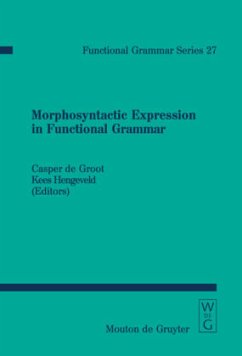This books reflects the growing interest within Functional Grammar for the further development of the syntactic and morphological components of the model. The papers in this volume discuss two recent developments, the Dynamic Expression Model for Functional Grammar and the conversion of this model into a Functional Discourse Grammar model, synopses of which are included. Further articles provide detailed analyses of a range of semantic and pragmatic categories and their morphosyntactic expression in a wide variety of languages. The articles in this book include data on some 60 different languages.
Morphological and syntactic issues have received relatively little attention in Functional Grammar, due to the fact that this grammatical model, given its functional orientation, was primarily concerned with developing its pragmatic and semantic components. Now that these have been solidly developed, this book turns to the further development of the syntactic and morphological components of the model.
Two recent developments receive pride of place: Bakker's Dynamic Expression Model and Hengeveld and Mackenzie's Functional Discourse Grammar. The first model aims at accounting for the complex interactions that one finds in many languages between the sets of expression rules that have to account for form on the one hand and those that establish order on the other. The second model takes a further step by considering morphosyntactic and phonological representations to be part of the underlying structure of the grammar rather than as the output of that grammar, contrary tothe original assumptions in FG.
The book accordingly contains synopses of these two proposals as well as applications of these to a variety of linguistic phenomena. Further articles provide detailed analyses of a range of semantic and pragmatic categories and their morphosyntactic expression in a wide variety of languages. The articles in this book contain data on some 60 different languages, including focused articles on phenomena in Arabic, Danish, English, Lengua de Señas Española, Mapudungun, Plains Cree, and Tanggu.
In all, the contributions to this volume show that the issue of morphosyntactic expression in Functional Grammar is very much alive and moving into promising new directions, while at the same time contributing to a better understanding of a large number of morphosyntactic phenomena in a wide variety of languages.
Morphological and syntactic issues have received relatively little attention in Functional Grammar, due to the fact that this grammatical model, given its functional orientation, was primarily concerned with developing its pragmatic and semantic components. Now that these have been solidly developed, this book turns to the further development of the syntactic and morphological components of the model.
Two recent developments receive pride of place: Bakker's Dynamic Expression Model and Hengeveld and Mackenzie's Functional Discourse Grammar. The first model aims at accounting for the complex interactions that one finds in many languages between the sets of expression rules that have to account for form on the one hand and those that establish order on the other. The second model takes a further step by considering morphosyntactic and phonological representations to be part of the underlying structure of the grammar rather than as the output of that grammar, contrary tothe original assumptions in FG.
The book accordingly contains synopses of these two proposals as well as applications of these to a variety of linguistic phenomena. Further articles provide detailed analyses of a range of semantic and pragmatic categories and their morphosyntactic expression in a wide variety of languages. The articles in this book contain data on some 60 different languages, including focused articles on phenomena in Arabic, Danish, English, Lengua de Señas Española, Mapudungun, Plains Cree, and Tanggu.
In all, the contributions to this volume show that the issue of morphosyntactic expression in Functional Grammar is very much alive and moving into promising new directions, while at the same time contributing to a better understanding of a large number of morphosyntactic phenomena in a wide variety of languages.
"If the editors of the Functional Grammar Series intended it to go out with a bang, they have certainly succeeded. This is a very valuable collection of papers that contributes both to the development of the theory into one that truly takes discourse into account, as well as to the understanding of problematic phenomena in a variety of languages. Linguists already working within F(D)G or in other functionally oriented frameworks will find much to inspire them in this book."
Inge Genee in: Linguistlist 16.3450/2005
Inge Genee in: Linguistlist 16.3450/2005

